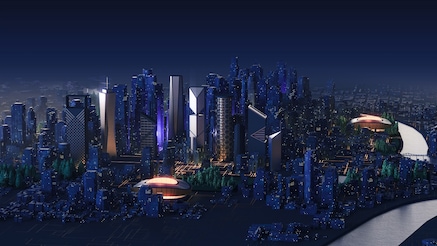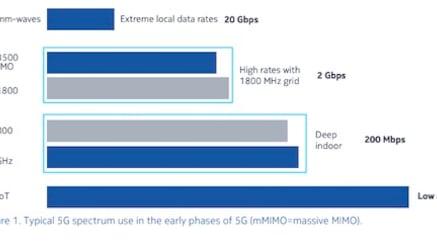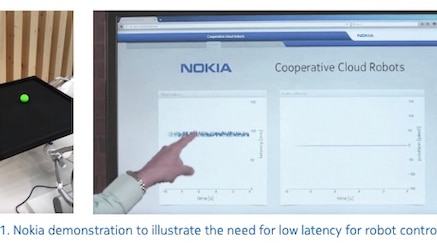5G myths debunked
Take the quiz
5G facts and myths
5G facts and fiction, it’s time to debunk some 5G myths. From cloud gaming, low latency and energy efficiency, the need to find the truth behind this topic has never been more crucial. Like every new technology, certain myths arise that don’t stand up to more scrutiny. Take the 5G facts and fictions quiz.
#1 Does cloud gaming require 5G?
Yes, while cloud gaming can function on 4G, the quality of experience is lower when compared to 5G. Also, streaming multiplayer online games typically requires minimal (or zero) delays or lag during gameplay and higher resolution video to ensure a better quality of experience (QoE). That’s why 5G will be a step-change for online gaming.

White paper
Cloud gaming and 5G - Realizing the opportunity
#2 Is Wi-Fi adequate for wireless AR headsets?
Wi-fi may be fine for home use where you are moving within a limited area, but it won’t have the same level of consistent performance outdoors. The real-time mapping of the digital world to the physical world, which is one of the hallmarks of the spatial internet, requires a level of throughput and latency that can’t currently be found when we are walking, running or driving outdoors. However, it’s believed that 5G connectivity will open the floodgates for the mass adoption of AR and VR.
#3 Is Open RAN the same as CloudRAN?
The key concept of Open RAN is “opening” the protocols and interfaces between these various building blocks (radios, hardware and software) in the RAN. In an Open RAN environment, the RAN is disaggregated into three main building blocks: the Radio Unit (RU), the Distributed Unit (DU) and the Centralised Unit (CU) This opens up opportunities for innovations in the radio access network and allows service providers to mix and match radio products with a combination that matches their deployment scenario. Cloud RAN simply means that what was done in hardware can now be done in software (virtualized).

Topic
Open RAN
#4 Can ultra-low latency and high reliability only be achieved with 5G?
While you can achieve lower latency in 4G, down to 2ms of the radio interface (the time it takes to transmit data from a device to the base station), it cannot be combined with ultra-reliability for overall consistency of connection. This means it’s not reliable enough for certain applications in the industrial sector, such as critical safety systems. Ultra-low latency of <1ms can only be achieved in 5G. For comparison, the average reaction time for humans to a visual stimulus is 250ms or 1/4 of a second.
#5 Does 5G require new spectrum?
No, 5G can operate in the same spectrum bands as 2G, 3G and 4G ranging from 600Mhz upwards, either through refarming (taking existing spectrum bands and allocating them for 5G) or using a technology called dynamic spectrum sharing. However, for high-bands at 24Ghz-40Ghz or mid-band 3.5-6Ghz, new spectrum allocations would be required.

White Paper
5G new radio networks
#6 Can 5G penetrate buildings?
Yes, it can. The confusion here isn’t related to 5G as a technology, but the frequency that the signal is transmitted at. Because it’s this frequency that determines the distance the signal can travel and what obstructions it can pass through. At higher frequencies of 26Ghz and above, known as ‘high band’, the signal is prone to greater loss when transmitted from outside to inside a building. However, if the 5G signal is transmitted at the mid (3.5Ghz) or lower bands (<2.5Ghz) the desired signal propagation into buildings can be achieved.

White paper
5G deployment below 6 GHz
#7 Does 5G signal degrade faster than 4G?
It’s not about 5G specifically, but about the different spectrum bands/wavelengths used to transmit the signal. Typically, 2g/3g/4g operate only in lower spectrum bands/wavelengths, where the signal can travel further. 5G can operate at these same lower bands and additional higher bands. It’s only at the higher bands where the signal will not travel as far. So why use the higher bands at all? Well, they have more capacity for higher throughput, which supports increased bandwidth. This allows for better quality video services and faster internet access, particularly in high traffic areas such as city centers, stadiums, and transportation hubs like bus and train stations and airports.
#8 Is 5G energy efficient?
Yes, it is. The radio part of the network is typically the heaviest in terms of overall power consumption in a mobile network. A case study in Finland shows that the energy consumption in 4G networks today is less than 0.3 kWh per gigabyte, and 5G technology can lower the consumption by a factor of 10 in macro cells, and by a factor of 100 in small cells. Additionally, 5G networks can help lower CO2 emissions by enabling greater efficiency through the digitalization of physical industries such as mining, energy and utilities and manufacturing.

White paper
5G Network Energy Efficiency
#9 Will 5G increase the digital divide?
No, it won’t. In fact, forthcoming 5G standards are addressing capabilities to deploy 5G using non-terrestrial networks such as High Altitude Platforms (HAPS), that can provide coverage in very remote regions.
While 5G will initially be deployed in larger urban populated areas, it will be expanded relatively quickly as it can operate at many different spectrum bands. This will allow for a wider range of deployments into more suburban and potentially rural areas using Fixed Wireless Access to deliver broadband connectivity to more homes and businesses.

White paper
HAPS: Connect the unconnected
#10 Is China winning the 5G race?
No, China is not winning the 5G race. In terms of technology development, all companies, regardless of the country in which they operate, are working to the 3GPP standard which has an agreed timeline to ensure interoperation across networks and compatibility with all devices. While deployments are occurring on a larger scale in China, there are many live 5G networks across the world.
Take the quiz to find out what is the real truth about 5g!
Keen to learn more?

Webpage
Featured articles
Visions to the power of n. The content series amplifying unique visions on the hottest topics
